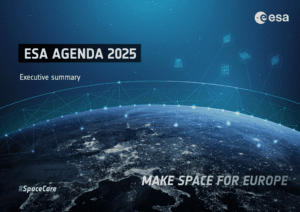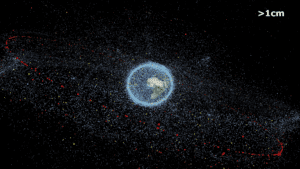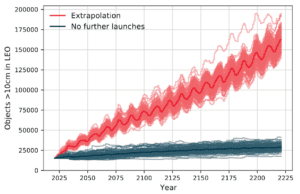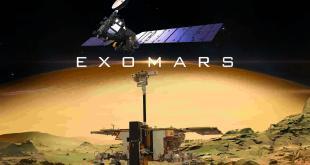by Vitali Braun, IMS Space Consultancy
The ESA Agenda 2025 – Opinions by members of the SichTRaum network

On April 7 this year, one month after Dr. Josef Aschbacher took office as the European Space Agency’s (ESA) new Director-General, the ESA Agenda 2025 was released.
This document contains the agenda of the new Director-General for the agency over/for the next four years. It outlines five priorities, which will have many long-term implications:
- Strengthening ESA-EU relations,
- Boosting space commercialization for a green and digital Europe,
- Developing space for safety and security,
- Addressing critical program challenges,
- Completing the internal transformation of ESA.
Although many of them come as no surprise, the urgency assigned to dealing with these priorities is unexpected – and welcome.
In this series of opinion pieces, members of the SichTRaum network provide their thoughts on some of the priorities, taking into account the broader context of the ongoing space sector transformations. SichTRaum is a network of researchers from various disciplines who look at human space exploration from the perspective of peace and security. It is an acronym for “Sicherheit und Technologie im Weltraum”, in English: “Security and Technology in Outer Space”. Find more information here.
—

The ESA Agenda 2025 recognises environmental sustainability as a key element of its policy, in fact being an integral part of several of the top priorities identified in addressing the issues of the Earth and the Space environment. The responsibility in environmental protection is underlined by ESA’s commitment to support “the implementation of the Paris Agreement and the European Green Deal to the fullest extent”. Moreover, the appointment of a senior climate and sustainability advisor to ESA’s Director General (DG) can be seen as a good step in the right direction, in combination with the planned creation of a sustainability fund and the willingness to establish sustainability practices with European industry.
Anthropogenic climate change is the major problem we are all facing. The moment we fail to subscribe to a life within the boundaries of our planet’s carrying capacity, all other aspects become meaningless. The goal described by the ESA Agenda 2025 to attain continued “growth […] decoupled from resource use” within a circular economy is obvious, but the path towards that goal remains unclear. More than 60 years of space flight activity have followed an essentially non-circular model and current orbital infrastructure deployed and planned is largely on the same path. The low-Earth orbit (LEO) environment today is congested such that ESA’s annual environment report 2021 projects a clearly negative scenario with an exponential increase in collision frequency (often referred to as the Kessler Syndrome) if we continue space activity as we have done over the last few years. This is especially disquieting in view of the clear lack of adherence to mitigation practices that have been established already in the 1990s – a predominantly non-technical problem. Moreover, the same report states that even if all launch activities would come to a halt today, the space debris environment would keep growing. But these results just confirm what the scientific/engineering community has established already more than a decade ago, before the NewSpace era even started. The skyrocketing number of annually launched satellites since 2017, and especially the deployment of multiple large satellite constellations with thousands of satellites each, will put the environment under significant additional pressure and in combination with an increased technological dependency of our societies appears to clearly boost the risk for major negative consequences on global scale. Better accessibility, here in terms of a “competitive and reusable launcher system” may create an additional environmental burden, as is also known from other domains. A major concern is also ESA’s support of the European Commissioner Breton’s plan for a large constellation of broadband telecommunication satellites. From this perspective, it remains questionable how ESA would achieve the diametrically opposite objectives of environmental protection and the inherently materialistic increase in space activity. The Agenda leaves open how ESA would actually envision “to invert Europe’s contribution to space debris by 2030” given that for typical satellites in low Earth orbit today about 80% of mission-terminating risk emanate from lethal non-trackable objects, too small to be seen from ground and thus well beyond our control. Every ESA mission launched today and in the future is thus necessarily contributing to pollution in a probabilistic sense, as the orbital footprint cannot be zero in the current environment. Space Traffic Management (STM) is a necessary element of the solution for the smaller portion of trackable space debris. However, given that the primary means to monitor objects in low Earth orbits are ground-based radars, assets that inherently serve national security interests, the advocacy for STM comes with a risk of further national fragmentation in Europe, given that in the last decade ESA’s Member States have failed to envision a common and shared programme in the space surveillance domain.

It further remains an important but unanswered question how the commercialisation that the Agenda is emphasizing on would support an environmental protection policy knowing that existing market mechanisms and industrialisation are among the primary causes of climate change and associated environmental degradation. It remains unclear how ESA addresses social responsibility in combination with its goal of technological independence, or autonomy, and at the same time can “fully embrace digital technologies”, knowing that especially the big tech sector is heavily dependent on raw materials in its supply chain extracted under inhumane conditions in low-income countries outside of Europe. And the electronic waste, including chemical pollutants, is mainly transferred back to those countries.
Overall, it appears that the ESA Agenda 2025 subscribes to ambitious goals in environmental protection, but it remains unclear how they will be achieved. And while the newly established senior advisor to the DG can be understood as a positive step, there is every reason for strong concern, especially in view of the rather conflicting jargon (“global leader”, “prestige”, “profit”, “envy of the world”) and other major objectives of the Agenda that rather put us on a path towards more environmental degradation given the lessons we learned from the past. How can we reasonably imagine a Mars landing as “humankind’s next historic venture”, a project that is inherently unsustainable and creates another risk burden, if the spirit of the time is rather to protect our own planet, the single habitable island within a radius of at least trillions of kilometres? In this respect, a lot of potential concerning the most pressing issues of our time remains uncalled. Alternative ways, building on Europe’s heritage in environmental protection and space debris expertise, could exist, for instance, in a stronger focus on implementing the precautionary principle – well established via the Lisbon treaty and already applied by the European states in the forest degradation and marine pollution domains. ESA could lead by example in establishing much-needed restraint mechanisms to preserve the space environment, but also the Earth environment (e.g. impact on launchers and re-entering satellites on the atmosphere). Instead of “creating the sufficient public demand”, we could start a dialogue on which missions are actually needed to help us understand and protect our planet, while thinking about relinquishment in other areas in order to preserve the environment for future generations. And we could think of an actual flagship programme that directly addresses environmental protection in the combined Earth and Space system.

After finishing his aerospace engineering studies in 2010, Vitali Braun joined the team at the Institute of Aerospace Systems, Technische Universität Braunschweig, as a research associate to study the modelling of the space debris environment. In that period, he worked on the development of software to facilitate risk assessments for space missions but also to study potential scenarios for the evolution of the space debris environment. Besides his support to university courses and teaching, he also began to focus on the domain of space surveillance and tracking, where he graduated with a Dr.-Ing. in 2016. Since 2015, he is working at ESA’s Space Debris Office on the continuous development of the European space debris reference model MASTER as well as the related software suite DRAMA, which is used by organisations world-wide in the compliance assessment of space missions with space debris mitigation requirements.





